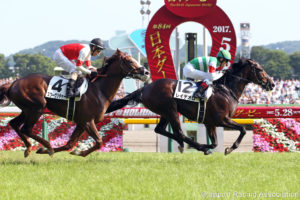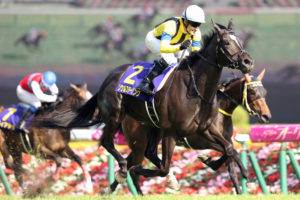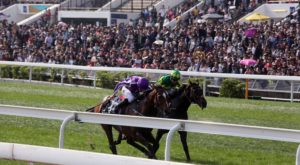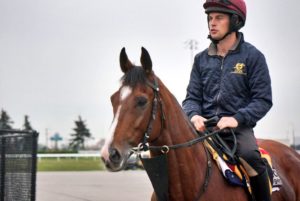
The Japan Cup (G1) has had only one repeat winner, Gentildonna (2012-13), but defending champion Kitasan Black is favored to join her in the record book in Sunday’s renewal at Tokyo.
The reigning Horse of the Year, Kitasan Black will meet an arguably deeper cast this time around, led by outstanding three-year-old Rey de Oro and a likely peaking Satono Crown. The internationals, out of luck here since 2005, have mustered a quartet comprising Aidan O’Brien’s Idaho, German rivals Iquitos and Guignol, and Australia’s Boom Time.
Kitasan Black dominated the 2016 Japan Cup in a tour de force front-running effort, but he’s not a need-the-lead type. Effectively employing stalk-and-pounce tactics in the April 2 Osaka Hai (G1), he did the same in his Tenno Sho Spring (G1) repeat in record time. Kitasan Black must have been feeling the effects of such a tough race over two metric miles, winding up an uncharacteristic ninth behind Satono Crown next time in the June 25 Takarazuka Kinen (G1). That prompted his connections – owner Saburo Kitajima (whose nom de course is Ono Shoji) and trainer Hisashi Shimizu – to scrap any idea of trying the Prix de l’Arc de Triomphe (G1).
In his comeback in the October 29 Tenno Sho Autumn (G1), Kitasan Black found himself much farther back than usual after flubbing the start, but he simply went to Plan B and rallied to beat Satono Crown anyway. While it’s possible that his stepping stone ended up being a more taxing contest than expected on soft going, all indications are that the champion is ready to fire in his title defense. Regular rider Yutaka Take will guide Kitasan Black from post 4 in his penultimate start, his swan song coming in Christmas Eve’s Arima Kinen (G1).

Once-beaten Rey de Oro, a blueblood by King Kamehameha from the family of Deep Impact (and his brother Black Tide, Kitasan Black’s sire), promises to offer a stern challenge. This summer’s Tokyo Yushun (Japanese Derby) (G1) hero in his previous try at about 1 1/2 miles, the Kazuo Fujisawa trainee steps up to face older horses for the first time. But his near-perfect record, sullied only by a returning fifth in the Satsuki Sho (Japanese 2000 Guineas) (G1), suggests he could be something special. If he hadn’t missed his intended prep ahead of that first classic, Rey de Oro would probably have performed up to his usual standard. In his latest, the September 24 Kobe Shimbun Hai (G2), he readily dismissed Kiseki, who flattered him by winning the Kikuka Sho (Japanese St Leger) (G1) in his next start.
Rey de Oro pointed for the Japan Cup instead of stretching out for that final classic. Christophe Lemaire, aboard for all six of his starts, has the return call as he breaks from post 2.
Although older horses have historically had the upper hand in the Japan Cup, the 2017 classic generation is punching above its weight so far this month. Suave Richard, second to Rey de Oro in the Japanese Derby, toppled older horses in the November 5 Copa Republica Argentina (G2), and it has become a trend in the first two races of Japan’s Autumn International Series. Three-year-old filly Mozu Katchan overturned her elders in the November 12 Queen Elizabeth II Cup (G1), and Persian Knight likewise struck for the younger set in the November 19 Mile Championship (G1), where sophomores swept three of the top four placings.

Their success also reflects well upon the other Fujisawa runner, Soul Stirring, who hopes to emulate Gentildonna by becoming just the second sophomore filly to win the Japan Cup. By Frankel and out of U.S. turf champ and French classic winner Stacelita, Soul Stirring beat Persian Knight during her championship season at two, and defeated Mozu Katchan in the May 21 Yushun Himba (Japanese Oaks) (G1). She thereby gave Frankel his first classic winner as a sire.
Resurfacing in the fall to try her luck against older males, Soul Stirring hasn’t had much. She was taken out of her usual game when trying to lead early the Mainichi Okan (G2) and tired to eighth behind Real Steel. Her sortie against Kitasan Black in the Tenno Sho Autumn never got airborne as she churned in sixth on the soft going. Soul Stirring would appreciate it if the ground dries out well ahead of Sunday, when she picks up a new rider in Cristian Demuro, taking over the mount from Lemaire on stablemate Rey de Oro.

Brother Mirco Demuro maintains his productive partnership with Satono Crown. He wasn’t aboard the progressive older horse for his breakthrough in last December’s Hong Kong Vase (G1), famously catching Highland Reel in the shadow of the post. But he has engineered Satono Crown’s back-to-back victories in the past two runnings of the Kyoto Kinen (G2) as well as his signature coup on Japanese soil, the aforementioned Takarazuka Kinen over the subpar Kitasan Black in June. The Noriyuki Hori veteran enjoyed a summer holiday, and returned with a strong second to Kitasan Black in the Tenno Sho Autumn over an inadequate 2,000 meters. The added ground will suit Satono Crown, who brings the smartest form of the four older horses attempting the Japan Cup for the first time.
The others in this category are Makahiki, Sciacchetra and Yamakatsu Ace. Makahiki, last year’s Japanese Derby hero, captured the Prix Niel (G2) at Chantilly but flopped in the 2016 Arc. The Deep Impact colt may be rounding back to his best with a fast-finishing fifth in the Tenno Sho Autumn. Sciacchetra and Yamakatsu Ace can be forgiven their disappointing efforts in the soggy Tenno Sho Autumn, since both fit if judged on their representative results. The lightly raced Sciacchetra, who didn’t even begin his career until last summer, beat a solid group in the March 25 Nikkei Sho (G2) and checked in a respectable fourth to Satono Crown in the Takarazuka Kinen. Multiple Grade 2 winner Yamakatsu Ace has nibbled at the highest level, finishing fourth to champion Satono Diamond and Kitasan Black in the Arima Kinen last Christmas, and third to Kitasan Black in the Osaka Hai.
Last year’s Japan Cup placegetters, runner-up Sounds of Earth and third Cheval Grand, are back for more. Since Sounds of Earth was also a useful fifth in his first Japan Cup in 2015, the race conditions tend to bring out the best in him. Yet the Grade 1 bridesmaid has yet to win a stakes and enters in less inspiring form this year. Thus Cheval Grand has more appeal in his bid to improve upon his 2016 finish. The multiple Grade 2 scorer was second in Kitasan Black’s record Tenno Sho Spring, most recently closed for third in the Kyoto Daishoten (G2), and now gets a rider switch to none other than Hugh Bowman – Winx’s pilot.
Rainbow Line, a pleasing sixth last year when cutting back from a runner-up effort in the Kikuka Sho (Japanese St Leger), may be poised for a better showing. Unplaced in his first three outings this campaign, the son of Stay Gold turned in his best performance of 2017 when third in the Tenno Sho Autumn. Fellow Japan Cup veterans Last Impact (the 2015 near-misser who was 10th in 2016), One and Only (unplaced in the past three runnings) and Decipher (15th back in 2014) are trying again but none looks in good enough nick at present.

Iquitos fared best of the foreigners (seventh) in the 2016 Japan Cup, but the reigning German Horse of the Year has a fight on his hands to retain that honor. Although Idaho has yet to transfer his European form to his three forays to North America, failing in this summer’s Sword Dancer (G1) and the last two runnings of the Canadian International (G1), the full brother to globetrotting money-spinner Highland Reel is reportedly showing more verve so far in his Japanese venture. The Ballydoyle runner needs to conjure more than was required in his victory in Royal Ascot’s Hardwicke (G2), or his placings in last year’s Derby (G1) and Irish Derby (G1) – Idaho must duplicate his third to Enable and Ulysses in the midsummer King George VI & Queen Elizabeth (G1) to be in with a shout.
As if the O’Brien interest weren’t enough, Iquitos has a nearer threat to deal with in compatriot Guignol, who’s bested him in three of four meetings this campaign. Guignol’s forward style has propelled him to scores over Iquitos in the Grosser Preis der Badischen Wirtschaft (G2), Grosser Preis von Baden (G1), and most recently the Grosser Preis von Bayern (G1) for the second straight year. Iquitos finished ahead of Guignol when they were second and fourth, respectively, in the Grosser Hansa Preis (G2) back in July, the prelude to Iquitos’ success in the July 30 Grosser Dallmayr-Preis (G1).
The Europeans’ form ties into the Arc, where Iquitos and Idaho were seventh and eighth respectively. Australia’s Boom Time has a steeper form hill to climb, having earned his signature win in the October 21 Caulfield Cup (G1). A 50-1 longshot at Caulfield, he made the most of a favorable weight, and a tactical jump on O’Brien’s favored Johannes Vermeer. Boom Time couldn’t get close on the step up to two metric miles in the Melbourne Cup (G1), finishing 15th behind Rekindling and Johannes Vermeer. Reverting to this distance helps, but he’s otherwise been put in his place at the Group 1 level. At least trainer David Hayes sent out the last Antipodean winner of the Japan Cup, Better Loosen Up, who plundered the 1990 edition for Australia the year after Horlicks won for New Zealand.
While the Anzac drought in the Japan Cup is of longer duration, the Europeans haven’t launched a successful invasion in a dozen years, since Alkaased set the record in a photo with Heart’s Cry. Skimming past Falbrav’s victory in the shortened 2002 running at Nakayama, the previous European to beat the Japanese in Tokyo was Pilsudski back in 1997.
The balance of Japan Cup power has definitely tilted in favor of the home team. Bonuses are offered to entice the winners of two dozen Group 1 races, spanning Europe, North America, Dubai, and Australia, to participate. Boom Time, as the Caulfield Cup winner, and Guignol, for prevailing at Baden-Baden, each receive a $100,000 “incentive” just for competing in the Japan Cup, and they are eligible for lucrative bonuses if cracking the top three – $2 million for a Japan Cup win, $400,000 for second, and $250,000 for third.




Why can’t we get PP and more stats from Japanese racing?
The races are run much more fairly and the payouts are great !!